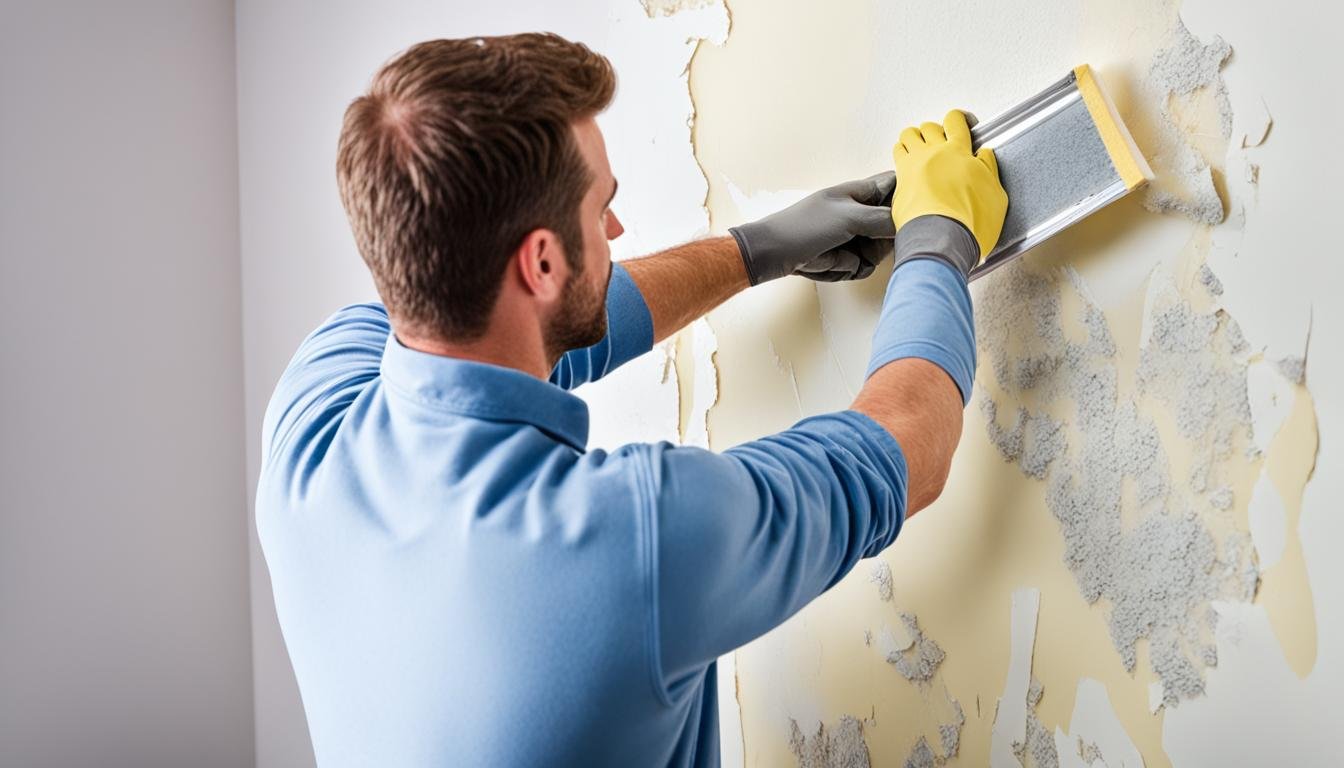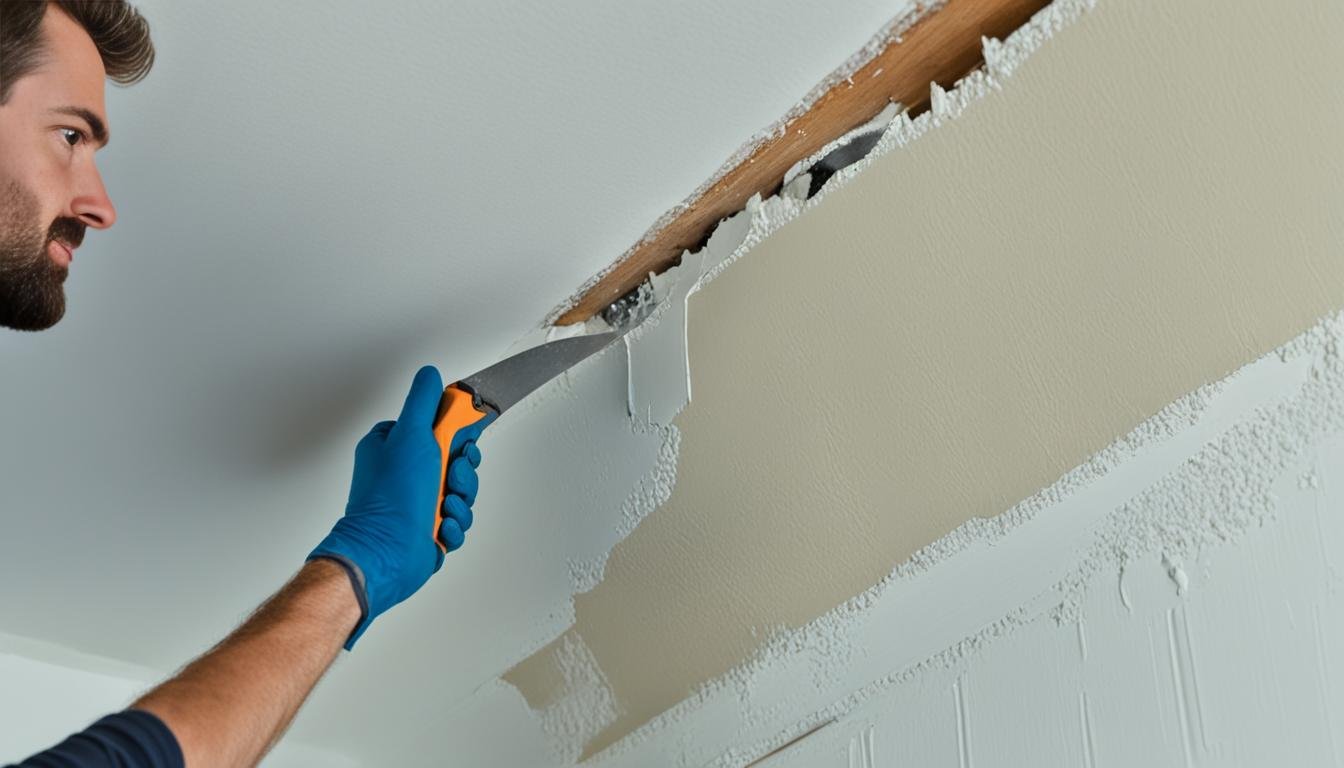Repairing Water-Damaged Walls
Did you know wet drywall can take up to three days to dry completely? Homeowners often deal with this as part of fixing water damage. This type of damage can happen from many sources, like a burst pipe or a leaky roof. It can cause issues such as mold and harm to the structure of the house. Fixing water-damaged walls is tough but needed for your house’s health. It might cost you at least $50 for small repairs. But, if the damage is bad, the price can go up fast. It may take a person over 2 hours to fix it if they know what they are doing. If the damage is big or involves black mold, it’s often wise to call a pro. The cost of professional help can vary. Yet, it’s usually a good idea for a solid and long-lasting repair. Key Takeaways Water damage can lead to a host of problems, including mold, mildew, and structural compromise. Repairing water-damaged walls can be a costly and time-consuming process, with the project cost starting at $50 for small sections. Dealing with water damage requires a thorough approach, as it can take up to three days for wet drywall to fully dry. While repairing water-damaged walls is an intermediate-level task, professional help may be necessary in certain situations. Addressing water damage quickly is crucial to prevent the issue from escalating and causing further damage to your home. Identifying and Addressing the Source of Water Damage The first step to tackle water damage is finding its source. Look out for Signs of Water Damage like loose paint, soft drywall, and musty smells. These can be hints water is getting in from outside. It might come through a leaky roof, a broken pipe, or from poorly sealed doors and windows. Locating the Leak or Moisture Source Finding where the water is coming from isn’t always easy. Water can spread far from the leak. To spot the leak, you might need to cut out damaged drywall. This gives a clearer look at what’s causing the issue. It could be a roof leak, a broken pipe, or even a dripping appliance. You need to find and fix the leak before repairing any damage. Addressing Mold Growth and Remediation If water damage goes unnoticed for too long, mold can start growing. Some molds, like “black mold,” are dangerous. Professional Mold Remediation is the best way to handle them. For small areas, you can clean the mold yourself. Just be sure to wear protective gear like gloves and a mask. Taking care of Indoor Air Quality is key for a safe home. Dealing with water damage quickly is vital. Plumbing Repairs and Home Inspections can stop the problem at the source. Sometimes, you might need experts for Water Leak Detection and Mold Remediation on complicated jobs. By fixing the main issue and any side problems, you can prevent lasting damage to your home. Repairing Water-Damaged Walls Repairing water-damaged walls starts with how bad the damage is. For small spots on the drywall, fixing it means cutting out the bad part and replacing it. Remove the damaged drywall, fit a scrap of 1-inch by 3-inch into the hole, and fasten a new piece on top. Step two is adding drywall tape and smoothing joint compound over the seams. Once that’s dry, sand and texture the area. This makes the repair invisible, blending it with the rest of the wall. If your wall has a lot of water damage, like needing a full new piece of drywall, you might want a pro to handle it. Big repair jobs are more complicated and may need special tools. Professionals will make sure it’s done right for a strong fix. Use Drywall Repair techniques for small sections of damaged drywall Incorporate Wall Patching methods to blend the new drywall with the existing wall Consider Drywall Installation for more extensive damage that requires a full sheet replacement Ensure proper Moisture Barrier techniques are used to prevent future water damage Consult professionals for complex Water Damage Restoration projects Acting fast on any water damage is key to preventing worse issues like mold. Using the right repair methods and being careful can bring your walls back to normal. It also helps keep your home safe from water damage problems in the future. “Water-damaged walls require prompt and thorough attention to prevent long-term structural issues and potential health hazards.” Preparing and Painting the Repaired Surface After fixing the drywall, the next move is to get it ready for paint. First, put a water-based primer on it. This helps the new paint stick correctly, stopping water damage. If the wall has a texture, add a matching spray texture according to the instructions. Make sure the repaired area is dry before painting. Opening windows and working in a space with good airflow is important. This makes the paint dry well and lessens any moisture problems. Choosing the right paint is key for interior walls. Pick a top-quality, waterproof paint for a good finish. Put on two coats for a full covering. Blend the paint well with the rest of the wall. If needed, use a technique for wall texturing to match the old finish. Protect yourself when applying the primer and paint. Wear a mask, gloves, and goggles. And always work in a space that has plenty of fresh air. These steps make sure your home project goes well. You’ll have your walls looking as good as new. Step Description 1. Apply Primer Apply a water-based primer/sealer to the repaired area to help the new paint adhere properly and prevent future water damage. 2. Texture the Wall If the wall has a textured finish, apply a matching texture spray according to the manufacturer’s instructions. 3. Paint the Repaired Area Use a high-quality, water-resistant paint and apply two coats for full coverage, blending the edges seamlessly with the surrounding wall. 4. Prioritize Safety Wear a mask, gloves, and eye protection, and ensure the work area is well-ventilated …




